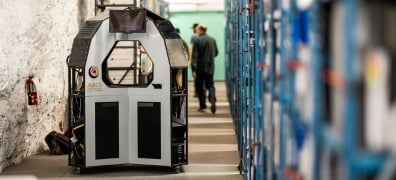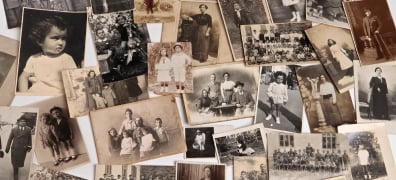Vision 2031: The film archive of the future
Blogs and Articles
Media & Archive Services' Director of Premium Archival Services, Hillary Howell, envisions the effective film archive of the future.

My name is Hillary Howell and I am the director of premium archival services at Iron Mountain Media and Archive Services. After graduating from UCLA with my masters in Moving Image Archive Studies I made a choice to focus on working within the studio system and helping to preserve the films and tv I love with the companies who made them. I’ve worked with every type of media in my career from nitrate film to born digital assets and the biggest lesson I’ve learned is that even as technology advances archivists still need to understand the film, video and audio assets of the past.
10 years from today most archival work will be digital. Archivists will maintain cloud storage and metadata. As content is king, providing quick access to that material in a secure manner is what many archivists will be doing every day. Virtual vaults are the future because they allow for easier distribution of content. But archives aren’t just about access, they are also about preservation. Archives need to strike a balance between their physical and digital assets. A colleague I discussed this with made a great point - one is not more important than the other now and that will still be true in ten years.
Formats, codecs and resolutions are always changing, that is the only constant in media. From nitrate to acetate to polyester film, from 1” or 2” video to HDCam SR to Pro Res to DPX, the technology continuously improves. We don’t know what new formats will be in common use in 10 years, but being able to provide the best available image for distribution will sometimes require physical assets.
Film has survived for over 100 years and as long as it is stored correctly should last hundreds more. As technology advances and standards move from 2K to 4K to 8K and beyond, the way to achieve the best possible image is to return to original film elements and scan them. I learned this lesson by proxy. A company bought an older film library in the 1980s. In order to license the content they telecined all the film to 1” video, the best format on offer at the time. Then they threw out all the film. The next person to buy that library was trapped with standard definition video rather than the film assets that would have allowed them to release in HD and better. I don’t see scanning film at 4K and then throwing it away as being any different. Being able to go back and rescan that film in a higher resolution gives you the best image well into the future.
As more streaming services come to be and more content is needed companies will mine their library for anything and everything it has to offer. This will mean continuing to transfer material thought unsellable in the past and left to sit on a shelf to provide constant programming. That material might be on obsolete formats, be they audio or video. It might also require going back to the original film assets and recutting them. More archivists should know how to handle the machines needed to digitize those assets, or at the very least understand how they work, which is only going to become more difficult as we are further removed from their invention. Apprenticeships and internships must continue to pass knowledge forward, not just to understand the various media formats but also how to transfer them. Studios and labs have to continue to train future archivists, engineers and operators to work, repair and maintain obsolete equipment so those assets aren’t lost to history.
Constant migration of obsolete assets is necessary to ensure their survival. But that will always be an ongoing process. And there is no replacement for film if you have it. Ease of use is very important, but so is the integrity of the original. I am not advocating for ignoring the future and the importance of a digital archive. My only request is that we don’t forget where we came from.
I’m very excited to be the first on staff archivist for Iron Mountain Media and Archive Services and I am here to challenge how we think about the future as a company and to help our customers forward think as well. In this job every client is different, and I get to work with a wide variety of assets every day to try and find solutions for future-proofing. And I am grateful for it.
10 years from today most archival work will be digital. Archivists will maintain cloud storage and metadata. As content is king, providing quick access to that material in a secure manner is what many archivists will be doing every day. Virtual vaults are the future because they allow for easier distribution of content. But archives aren’t just about access, they are also about preservation. Archives need to strike a balance between their physical and digital assets. A colleague I discussed this with made a great point - one is not more important than the other now and that will still be true in ten years.
Formats, codecs and resolutions are always changing, that is the only constant in media. From nitrate to acetate to polyester film, from 1” or 2” video to HDCam SR to Pro Res to DPX, the technology continuously improves. We don’t know what new formats will be in common use in 10 years, but being able to provide the best available image for distribution will sometimes require physical assets.
Film has survived for over 100 years and as long as it is stored correctly should last hundreds more. As technology advances and standards move from 2K to 4K to 8K and beyond, the way to achieve the best possible image is to return to original film elements and scan them. I learned this lesson by proxy. A company bought an older film library in the 1980s. In order to license the content they telecined all the film to 1” video, the best format on offer at the time. Then they threw out all the film. The next person to buy that library was trapped with standard definition video rather than the film assets that would have allowed them to release in HD and better. I don’t see scanning film at 4K and then throwing it away as being any different. Being able to go back and rescan that film in a higher resolution gives you the best image well into the future.
As more streaming services come to be and more content is needed companies will mine their library for anything and everything it has to offer. This will mean continuing to transfer material thought unsellable in the past and left to sit on a shelf to provide constant programming. That material might be on obsolete formats, be they audio or video. It might also require going back to the original film assets and recutting them. More archivists should know how to handle the machines needed to digitize those assets, or at the very least understand how they work, which is only going to become more difficult as we are further removed from their invention. Apprenticeships and internships must continue to pass knowledge forward, not just to understand the various media formats but also how to transfer them. Studios and labs have to continue to train future archivists, engineers and operators to work, repair and maintain obsolete equipment so those assets aren’t lost to history.
Constant migration of obsolete assets is necessary to ensure their survival. But that will always be an ongoing process. And there is no replacement for film if you have it. Ease of use is very important, but so is the integrity of the original. I am not advocating for ignoring the future and the importance of a digital archive. My only request is that we don’t forget where we came from.
I’m very excited to be the first on staff archivist for Iron Mountain Media and Archive Services and I am here to challenge how we think about the future as a company and to help our customers forward think as well. In this job every client is different, and I get to work with a wide variety of assets every day to try and find solutions for future-proofing. And I am grateful for it.
Featured services & solutions
Related resources
View More Resources
Solution Guides
Automated Media Image Capture by Iron Mountain Media & Archive Services
Discover how Iron Mountain Media & Archive Services' Automated Media Image Capture System (AMICS) revolutionizes archival digitization.


